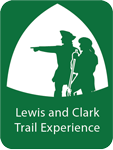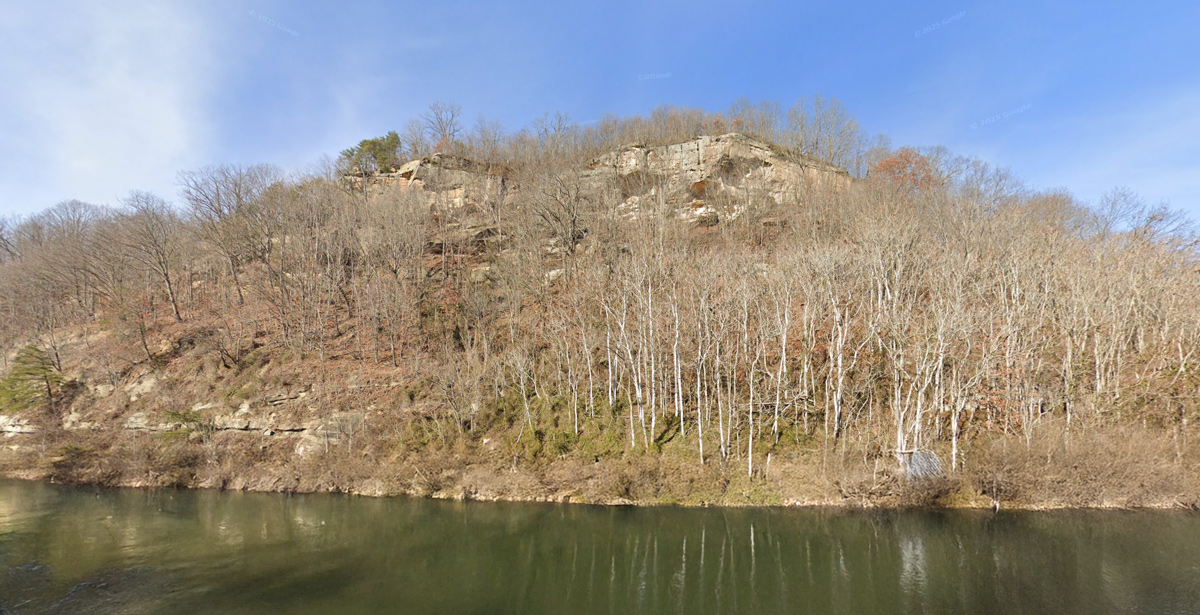On or near this date, Lewis passes a notable hanging rock and the Ohio River towns of Alexandria (present Portsmouth, Ohio) and Vanceburg, Kentucky. He provides no journal entry, but other travelers—Fortescue Cuming and Thomas Rodney—describe the area.[1]Because we have no journal entry from Lewis for this day, his exact location is unknown. He was at Letart Falls on 18 September and arrived in Cincinnati on 28 September. Based on Thomas … Continue reading
Today, the small community of Hanging Rock is nestled just upriver from the cliff the town is named after.[2]Henry Gannett, The Origin of Certain Place Names in the United States (Washington: Government Printing Office, 1905), 148. The above photo has been altered. The Hanging Rock cliff has not been changed, but the Ohio River Byway below it has been replaced with a river.
Cuming’s Hanging Rock
[O]n the right is a small insulated mountain named Hanging Rock, from its being a bare perpendicular rock, from half the elevation to the top.
This is a very picturesque and agreeable object to the eye, fatigued with the perpetual sameness of the banks below Point Pleasant.
—Fortescue Cuming c. 1807[3]Fortescue Cuming (1762–1828), wrote his journal primarily in 1807. F. Cuming, Sketches of a Tour to the Western Country: Through the States of Ohio and Kentucky, a voyage down the Ohio and … Continue reading
Rodney’s Hanging Rock
Here I recollect that I omitted to mention the appearance of a cuerious rock on the mountain on the Kentucky shore just before we saw Alexandra round the point. It was an oblong laying like a table on one edge and the upper corners ovalled off a little. It stood on the top of a nob of the mountain and perhaps was 60 ft. long and 15 ft. high. The face was green as if covered with moss and the top edge was crowned with a row of ceaders.
—Thomas Rodney (1 October 1803)[4]Dwight L. Smith and Ray Swick, ed., A Journey Through the West: Thomas Rodney’s 1803 Journal from Delaware to the Mississippi Territory (Athens: Ohio University Press, 1997), 91.
Portsmouth, Ohio
We met with no further impediment to Great Siota which we arrived at about half after eleven; and I went on shore to git some whisky and to see the town of Alexandria, which stands on a hill of high land on the uper side of the Sciota but facing the Ohio. In a street parallel to with the river there is about 20 ordinary logged houses and cabins in it and one framed and one stone house, but few of the buildings finished and the inhabitants miserably poor.
—Thomas Rodney (1 October 1803)[5]Ibid., 90.
The Portsmouth location had been settled by the Ohio Hopewell culture between 100 and 500 AD and much of the Portsmouth Earthworks Complex can still be seen in the city’s Mound Park. The complex was the gateway to their Scioto River villages and extended seven miles on both sides of the Ohio. By mid-17th century, it was a Shawnee village along the Warrior Trail that connected the Cherokee country to the south with the Lake Erie country to the north.[6]William F. Romain, Mysteries of the Hopewell: Astronomers, Geometers, and Magicians of the Eastern Woodlands (Akron, Ohio: The University of Ohio Press, 2000), 19, 26 available at … Continue reading
Europeans began settling in the 1790’s and in 1803, a new location a bit higher up was plotted to avoid flooding. Thus, when Meriwether Lewis passed by in September 1803, the town of Alexandria transitioning to the new Portsmouth site.[7]“Portsmouth”, Portsmouth, Ohio, en.wikipedia.org/wiki/Portsmouth,_Ohio, accessed 25 January 2025.
Vanceburg Salt Works
There is a hansom settlement and little town here on the Kentucky shore and a salt works ¼ mile out of town on Salt Lick Creek.
—Thomas Rodney (1 October 1803)[8]Rodney called the town Vance Ville, today’s Vanceburg at the mouth of Salt Lick Creek. Ibid., 91.
Experience the Lewis and Clark Trail
The Lewis and Clark Trail Experience—our sister site at lewisandclark.travel—connects the world to people and places on the Lewis and Clark Trail.
Plan a trip related to September 22, 1803:

Notes
| ↑1 | Because we have no journal entry from Lewis for this day, his exact location is unknown. He was at Letart Falls on 18 September and arrived in Cincinnati on 28 September. Based on Thomas Rodney’s journal of his similar trip down the Ohio and Cramer’s 1802 river guide, The Navigator, one conjecture is that Lewis stopped for the day somewhere near the 1803 settlement of Vanceburg, Kentucky. |
|---|---|
| ↑2 | Henry Gannett, The Origin of Certain Place Names in the United States (Washington: Government Printing Office, 1905), 148. |
| ↑3 | Fortescue Cuming (1762–1828), wrote his journal primarily in 1807. F. Cuming, Sketches of a Tour to the Western Country: Through the States of Ohio and Kentucky, a voyage down the Ohio and Mississippi rivers, and a trip through the Mississippi territory, and part of West Florida, commenced at Philadelphia in the winter of 1807 . . . (Pittsburgh: Cramer, Spear, & Eichbaum, 1810), 136. |
| ↑4 | Dwight L. Smith and Ray Swick, ed., A Journey Through the West: Thomas Rodney’s 1803 Journal from Delaware to the Mississippi Territory (Athens: Ohio University Press, 1997), 91. |
| ↑5 | Ibid., 90. |
| ↑6 | William F. Romain, Mysteries of the Hopewell: Astronomers, Geometers, and Magicians of the Eastern Woodlands (Akron, Ohio: The University of Ohio Press, 2000), 19, 26 available at archive.org/details/mysteriesofhopew0000will/; “Mound Park”, Ohio History Connection, www.ohiohistory.org/preserving-ohio/state-historic-preservation-office/shpo-awards/mound-park/ accessed 24 January 2025. |
| ↑7 | “Portsmouth”, Portsmouth, Ohio, en.wikipedia.org/wiki/Portsmouth,_Ohio, accessed 25 January 2025. |
| ↑8 | Rodney called the town Vance Ville, today’s Vanceburg at the mouth of Salt Lick Creek. Ibid., 91. |

